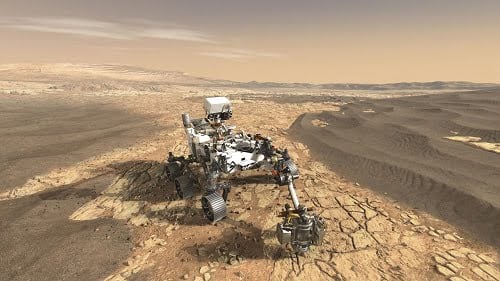
NASA Mars 2020 to Use Spectroscopy, Fluorescence Imaging in Biosignature Analysis
WASHINGTON, D.C., Sept. 6, 2017 — NASA's Mars 2020 mission, which will look for signs of past life on Mars, will use smart methods originally developed to find the oldest life on Earth.

A concept image of the Mars 2020 Rover. Courtesy of NASA/JPL-Caltech.
The 2020 mission builds on the successes of prior rovers to make coordinated measurements that could detect signs of ancient life – or biosignatures – in their original spatial context. These techniques, known as spatially resolved biosignature analysis, derive from geochemical analysis of early life on Earth.
"Previous missions to Mars have used a relatively broad brush – analyzing average chemistry over roughly the size of a postage stamp – to follow the water and seek ancient habitable environments,” said Ken Williford, director of the Jet Propulsion Laboratory’s Astrobiogeochemistry Laboratory. “Mars 2020 takes the next natural step in its direct search for evidence of ancient microbial life, focusing measurements to the microbial scale and producing high-resolution maps over similarly postage stamp-sized analytical areas.”
New scientific methods for searching for the most ancient evidence for life on Earth have led to a leap forward in capabilities for biosignature detection. Rather than using bulk geochemistry techniques that measure the average composition of a rock, Mars 2020 is developing new capabilities including x-ray fluorescence and Raman spectroscopy to map the elemental, mineral and organic composition of rocks at high spatial resolution, with analytical spot sizes about the width of a human hair. Understanding the spatial distribution of chemical features preserved in ancient rocks is key to determining whether or not they were formed by life.
The Mars 2020 mission will also use the knowledge gained from its scientific exploration to select and collect key samples that could one day be examined in laboratories back on Earth. Thirty to 40 rock and sediment core samples, about 15 g each, will be hermetically sealed in titanium tubes and deposited in a safe location on the surface of Mars for possible retrieval by a future mission.
"Mars 2020 represents a crucial first step toward a possible Mars sample return,” Williford said. “Our objective is to collect a diverse set of samples from our landing site with the best potential to preserve records of the evolution of Mars, including the presence of life if it was there. We'll use our onboard instruments to provide the critical field context that future scientists would need to understand the measurements made back on Earth."
Published: September 2017